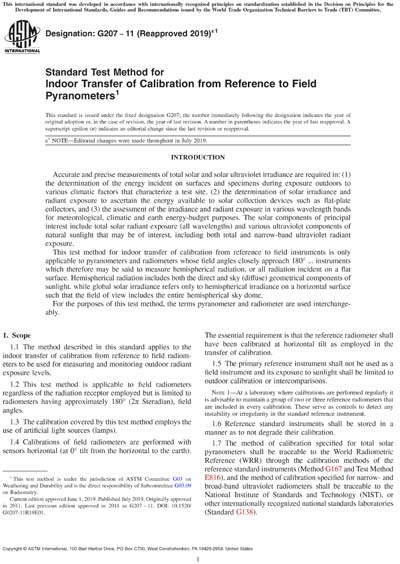Most recent
ASTM G207-11(2019)e1
Standard Test Method for Indoor Transfer of Calibration from Reference to Field Pyranometers
1.1 The method described in this standard applies to the indoor transfer of calibration from reference to field radiometers to be used for measuring and monitoring outdoor radiant exposure levels.
1.2 This test method is applicable to field radiometers regardless of the radiation receptor employed but is limited to radiometers having approximately 180° (2π Steradian), field angles.
1.3 The calibration covered by this test method employs the use of artificial light sources (lamps).
1.4 Calibrations of field radiometers are performed with sensors horizontal (at 0° tilt from the horizontal to the earth). The essential requirement is that the reference radiometer shall have been calibrated at horizontal tilt as employed in the transfer of calibration.
1.5 The primary reference instrument shall not be used as a field instrument and its exposure to sunlight shall be limited to outdoor calibration or intercomparisons.
Note 1: At a laboratory where calibrations are performed regularly it is advisable to maintain a group of two or three reference radiometers that are included in every calibration. These serve as controls to detect any instability or irregularity in the standard reference instrument.
1.6 Reference standard instruments shall be stored in a manner as to not degrade their calibration.
1.7 The method of calibration specified for total solar pyranometers shall be traceable to the World Radiometric Reference (WRR) through the calibration methods of the reference standard instruments (Method G167 and Test Method E816), and the method of calibration specified for narrow- and broad-band ultraviolet radiometers shall be traceable to the National Institute of Standards and Technology (NIST), or other internationally recognized national standards laboratories (Standard G138).
1.8 This standard does not purport to address all of the safety concerns, if any, associated with its use. It is the responsibility of the user of this standard to establish appropriate safety, health, and environmental practices and determine the applicability of regulatory limitations prior to use.
1.9 This international standard was developed in accordance with internationally recognized principles on standardization established in the Decision on Principles for the Development of International Standards, Guides and Recommendations issued by the World Trade Organization Technical Barriers to Trade (TBT) Committee.
ASTM International [astm]

